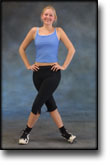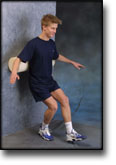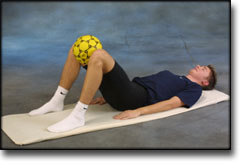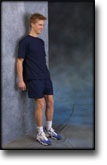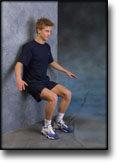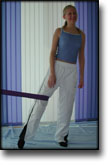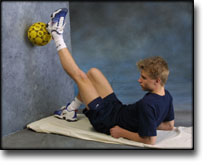|
Interventions for preventing and treating stress fractures and stress reactions of bone of the lower limbs in young adults. OBJECTIVES. SEARCH STRATEGY. SELECTION CRITERIA. DATA COLLECTION AND ANALYSIS. MAIN RESULTS. REVIEWER’S CONCLUSIONS. |
Alle indlæg af urtehave_com
examination-article2
|
Femoral stress fractures. |
examination-article1
|
Stress fractures of the femoral shaft in athletes–more common than expected. A new clinical test. |
cause-article
|
Risk factors for stress fractures. |
step4
Training ladder for:
RUPTURE OF THE INNER COLLATERAL LIGAMENT
(RUPTURA COLLATERALE LIGAMENTUM MEDIALE/TIBIALE)
STEP 4 |
Unlimited: Cycling. Swimming. Running and spurting with sudden directional change and jumping.
|
||||||||||||||||||||||||||||||||||||||||||||||||||||||||
|
Stretching is carried out in the following way: stretch the muscle group for 3-5 seconds. Relax for 3-5 seconds. The muscle group should subsequently be stretched for 20 seconds. The muscle is allowed to be tender, but must not hurt. Relax for 20 seconds, after which the procedure can be repeated. The time consumed for stretching, coordination and strength training can be altered depending on the training opportunities available and individual requirements. |
step3
Training ladder for:
RUPTURE OF THE INNER COLLATERAL LIGAMENT
(RUPTURA COLLATERALE LIGAMENTUM MEDIALE/TIBIALE)
STEP 3 |
Unlimited: Cycling. Swimming. Running with increasing speed and cautious directional change.
|
|||||||||||||||||||||||||||||||||||||||||||||||||||||
|
Stretching is carried out in the following way: stretch the muscle group for 3-5 seconds. Relax for 3-5 seconds. The muscle group should subsequently be stretched for 20 seconds. The muscle is allowed to be tender, but must not hurt. Relax for 20 seconds, after which the procedure can be repeated. The time consumed for stretching, coordination and strength training can be altered depending on the training opportunities available and individual requirements. |
step2
Training ladder for:
RUPTURE OF THE INNER COLLATERAL LIGAMENT
(RUPTURA COLLATERALE LIGAMENTUM MEDIALE/TIBIALE)
STEP 2 |
Unlimited: Cycling. Swimming. Light jogging.
|
|||||||||||||||||||||||||||||||||||||||||||||||||||||||||||
|
Stretching is carried out in the following way: stretch the muscle group for 3-5 seconds. Relax for 3-5 seconds. The muscle group should subsequently be stretched for 20 seconds. The muscle is allowed to be tender, but must not hurt. Relax for 20 seconds, after which the procedure can be repeated. The time consumed for stretching, coordination and strength training can be altered depending on the training opportunities available and individual requirements. |
step1
Training ladder for:
RUPTURE OF THE INNER COLLATERAL LIGAMENT
(RUPTURA COLLATERALE LIGAMENTUM MEDIALE/TIBIALE)
STEP 1 |
| The indications of time after stretching, coordination training and strength training show the division of time for the respective type of training when training for a period of one hour. The time indications are therefore not a definition of the daily training needs, as the daily training is determined on an individual basis.
|
||||||||||||||||||||||||||||||||||||||||||||||||||||||||
|
Stretching is carried out in the following way: stretch the muscle group for 3-5 seconds. Relax for 3-5 seconds. The muscle group should subsequently be stretched for 20 seconds. The muscle is allowed to be tender, but must not hurt. Relax for 20 seconds, after which the procedure can be repeated. The time consumed for stretching, coordination and strength training can be altered depending on the training opportunities available and individual requirements. |
step4
Training ladder for:
RUPTURE OF THE OUTER COLLATERAL LIGAMENT
(RUPTURA COLLATERALE LIGAMENTUM MEDIALE/TIBIALE)
STEP 4 |
Unlimited: Cycling. Swimming. Running and spurting with sudden directional change and jumping.
|
||||||||||||||||||||||||||||||||||||||||||||||||||||||||||
|
Stretching is carried out in the following way: stretch the muscle group for 3-5 seconds. Relax for 3-5 seconds. The muscle group should subsequently be stretched for 20 seconds. The muscle is allowed to be tender, but must not hurt. Relax for 20 seconds, after which the procedure can be repeated. The time consumed for stretching, coordination and strength training can be altered depending on the training opportunities available and individual requirements. |
step3
Training ladder for:
RUPTURE OF THE OUTER COLLATERAL LIGAMENT
(RUPTURA COLLATERALE LIGAMENTUM MEDIALE/TIBIALE)
STEP 3 |
Unlimited: Cycling. Swimming. Running with increasing speed and cautious directional change.
|
|||||||||||||||||||||||||||||||||||||||||||||||||||||||
|
Stretching is carried out in the following way: stretch the muscle group for 3-5 seconds. Relax for 3-5 seconds. The muscle group should subsequently be stretched for 20 seconds. The muscle is allowed to be tender, but must not hurt. Relax for 20 seconds, after which the procedure can be repeated. The time consumed for stretching, coordination and strength training can be altered depending on the training opportunities available and individual requirements. |







